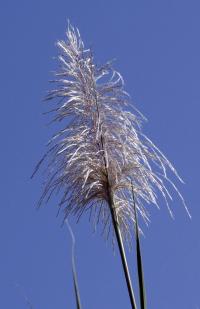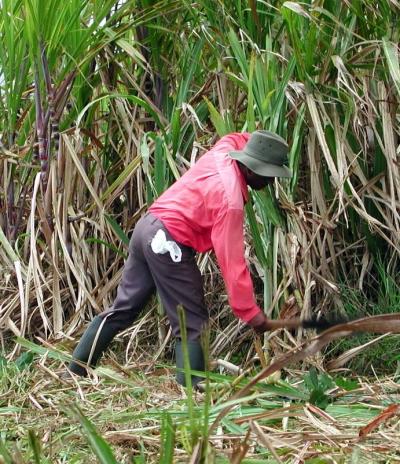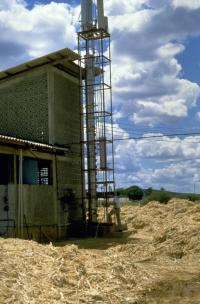Results & impact 27 March 2024
- Home
- Our activities, our impact
- Tropical value chains
- Sugarcane

Sugarcane
Sugarcane is a giant tropical grass from the family Graminaceae, whose stalk has the particular capacity to store a crystallizable sugar, sucrose. Its main use is in industrial processing of the stalks to make rum. However, the impressive plant mass it produces can also be converted into energy—combustible material, charcoal or biofuel—and also contains a wealth of molecules for the chemicals industry.
Sugarcane, a giant grass full of sugar
Sugarcane originated in Papua New Guinea. It belongs to the Graminaceae family and to the botanical genus Saccharum, which comprises three sugar-bearing species―S. officinarum, known as "noble cane", S. sinense, and S. barberi ―and three non-sugar-bearing species―S. robustum, S. spontaneum and S. edule. In the 1880s, agronomists began creating hybrids between noble cane and the other species. The modern varieties are all derived from those crosses.
A sugarcane plant is a tuft of between 5 and 20 upright stems, or "tillers", 2 to 5 metres tall and 2 to 4 centimetres in diameter. Each stem is a succession of nodes and internodes; each node bears a bud and a band of root primordia. The sugar is stored in the pith, under the hard, waxy bark. Cuttings a few nodes long are taken from the stems and used to replant cane fields every five to ten years. The stems are also very rich in cellulose and lignin, which have many uses in the green chemicals industry and as fuels, energy, materials, etc.
The plants bear many long, narrow leaves. Through photosynthesis, this large leaf area serves to produce plant matter, of which the main molecule is sugar. The leaves are also good fodder for livestock.
The root system is both dense and deep. This is why sugarcane protects soils efficiently, notably against erosion due to heavy rains and cyclones.
The inflorescence, or spike, is a panicle comprising a multitude of flowers that produce tiny seeds, known as "fuzz".
Like maize and sorghum, sugarcane is a "C4" plant. Their specific functioning enables them to absorb much more carbon dioxide (CO2) and sunlight than other plants. In exchange, they also give off more oxygen and produce substantial amounts of biomass. In sugarcane, this hyperactivity results in luxuriant vegetation and high sugar content.
Sugarcane originated on the island of Papua New Guinea. It followed the movements of people within the Pacific Ocean region, reaching Oceania, Southeast Asia, southern China and the Indus Valley in India. And it was in India that the history of sugar began... It is though that the Indians already knew how to extract cane sugar and make liqueurs from cane juice 5000 years ago. Caravan traders travelled throughout the East and Asia Minor selling sugar in the shape of crystallized loaves; sugar was a spice, a luxury good and a drug.
In the 6th century BC, the Persians invaded India and took home sugarcane and sugar extraction practices. They grew sugarcane in Mesopotamia and kept the secrets of extraction to themselves for more than 1000 years. The Arabs discovered those secrets after a battle against the Persians near Baghdad in 637 AD. They successfully developed sugarcane growing around the Mediterranean, as far as Andalusia, thanks to their mastery of farming techniques, notably irrigation. While the Arabo-Andalusian peoples became experts in sugar, for other European regions, it remained a rarity. It was not until the crusades, from the twelfth century onwards, that those regions really took an interest in it.
In the sugarcane fields
Sugarcane needs sunshine, water and heat. In areas without enough water, the fields are irrigated, like in Australia, sub-Saharan countries and the West of Réunion island.
It is a perennial crop, which grows back after each harvest. After five or six "regrowths", the old plants are pulled up and "virgin cane" is planted. Sugarcane is propagated by taking cuttings from the stem and burying them horizontally.
As the cane grows, sugar builds up in the stems, reaching a peak known as "maturity", which is the best time to harvest. Harvesting consists in cutting the stems, leaving the bottom, the "stubble", to allow the plant to grow back. Cutting is traditionally done by hand, using a machete, which is highly labour-intensive. It is a difficult operation, as sugarcane stems are hard, the leaves are sharp, it is usually very hot and there are many insects! As a result, mechanical methods are increasingly being used. A worker can cut between 3 and 5 tonnes of stems a day, while a mechanical harvester can cut up to 60 tonnes of stems an hour!
In very hot climates, for instance in Louisiana or Indonesia, the crop can be harvested 9 to 12 months after planting or regrowth, while in other, cooler regions, such as the highlands of Hawaii, or South Africa, it takes 18 to 24 months.
Once cut, the stems have to be transferred to the mill within two days, as their sugar content falls rapidly. Harvesting is therefore a crucial stage. It requires considerable organization in order to supply the factories that produce sugar, rum, ethanol fuel and other products.
In some regions, for instance in Réunion, sugarcane growing influences land use planning and contributes to the quality of the landscape and its attractiveness to tourists. Moreover, it has many environmental advantages: it is effective against erosion; it fosters energy self-sufficiency (the entire plant or some organs or sugar mill waste can be used to produce electricity and biofuels); and it can easily be fertilized by recycling all sorts of organic matter.
A highly coveted plant
Sugarcane grows so exuberantly that numerous insects love it: stem borer caterpillars; leaf miner caterpillars; whiteflies and nematodes, which attack the roots, and so on. Like all plants, sugarcane is subject to diseases, caused by bacteria, fungi or viruses.
After six months of growth, the vegetation is so dense that it is impossible to get into the field or to use pesticides. This is why breeders have always worked to create pest- and disease-resistant varieties. For their part, entomologists have developed biological control methods, consisting in using insects or fungi that are natural enemies of the pests concerned.
Fiji disease, caused by a virus transmitted by a small sucking insect (Perkinsiella saccharicida) had producing countries running scared until the 1960s. It causes elongated warts on the underside of the leaves; the leaves harden and dry out and the plant stops growing and eventually dies. The creation of quarantine facilities at research centres significantly reduced the spread of the disease.
In Réunion, to control a chafer, the soils are treated with granules containing spores of Beauveria brongniartii, a parasite of the grubs. The chafers are caught and dipped in a spore solution; when they fly off, they spread the spores within the sugarcane plantings and contaminate their fellow insects by contact.
A tiny wasp, called a trichogramma, is also used. It lays its eggs in a moth whose larvae mine through sugarcane stems. To do this, several tens of thousands of trichogrammas per hectare are released into the sugarcane fields.
From cane to sugar
Extracting sucrose, the sugar found in the stems, consists in isolating it from the rest of the plant. On entering the mill, each sugarcane batch is weighed and its sugar content is analysed. The stems are then crushed into rough fibre, using a hammer grinder.
To extract the juice, the fibres are simultaneously watered with hot water and pressed in a roller mill. The fibrous residue left after juice extraction is called bagasse, and can be used to fuel boilers to generate electricity.
The juice is heated, decanted and filtered after adding slaked lime, then concentrated by heating. This produces a "syrup" free of its "non-sugar" impurities, or scum, which can be used as a fertilizer. The syrup is heated in a pan, until it turns into "massecuite", containing a syrupy liquid, the liquor, and sugar crystals. That massecuite is then heated another twice, alternated with stirring and centrifugation operations, so as to obtain as great a volume of sucrose crystals as possible. The crystals are then sent for drying. The first sugars obtained are various grades of brown sugar. White sugar is produced by refining brown sugar, which is re-melted, decolourized and filtered, before being crystallized and dried. The sugars are then stored in watertight bins. White sugar is the favourite type for both consumers and industrialists.
What is left after crystallization is molasses, a sugary liquid rich in mineral and organic substances, which can be sent to a distillery to make rum.
Making rum
For thousands of years, sugarcane growing has been associated with fermented drinks. Rum as we know it started out in the Caribbean and Brazil in the 17th century. Traditional rums are made by fermenting molasses, which produces "industrial rum", or by fermenting cane juice, which gives "agricultural rum". The sugary wort is produced by diluting molasses or filtering cane juice.
Fermentation yeasts are multiplied in a mother tank and then transferred to other large tanks in which they convert the sugar in the wort into alcohol (ethanol). It is at this stage that rum aromas are formed. This produces a cane wine with 8 to 10° of alcohol. Fermentation takes between 12 and 36 days for light rums, and up to 10 days for "grand arôme" rums. In Guadeloupe, one tonne of sugarcane stems produces 85 to 120 litres of 55° proof agricultural rum.
Once fermentation is completed, the cane wine is transferred to stills, where it is heated to separate the alcohol from the water. At the top of the still, the alcohol vapours are cooled and collected in condensers. The distiller's art consists in keeping the most volatile aroma molecules, also known as the "spirit" of the rum.
The distillation residue, known as vinasse, is a pollutant. It can be recycled as a fertilizer or as an energy source. The 30 kilos of molasses obtained per tonne of stems give some 110 litres of vinasse.
The rum aromas continue to develop as it matures or ages. Spring water is added to obtain the desired degree of alcohol, and the rum is kept for several weeks in stainless steel vats, resulting in white rum.
Rums less than three years old are matured in wooden barrels. Old rums are matured for 3 to 10 years in oak barrels. The degree of alcohol for most rums varies between 37.5 and 62°.
Bagasse, molasses, ethanol…
Bagasse, which is primarily made up of cellulose, hemicellulose and lignin, is a source of energy (it can be burnt), and of fodder for livestock. It is also a raw material for making paper, cardboard, thermal insulation, films and textiles. Molasses is used to feed animals, grow yeasts are produce acids.
The sucrose undergoes a range of chemical processes to make ethers and esters, which in turn serve to make plasticizers, adhesives, cosmetics, varnishes, etc.
The ethanol obtained after fermenting the juice or molasses can be used pure as a biofuel. In Brazil, more than half of the sugarcane crop is used to make fuel ethanol, and most cars run on ethanol. Cane varieties have been specially bred for ethanol production. The ideal solution for larger-scale production would be to use the whole plant: research is under way to produce ethanol directly from cellulose.









































